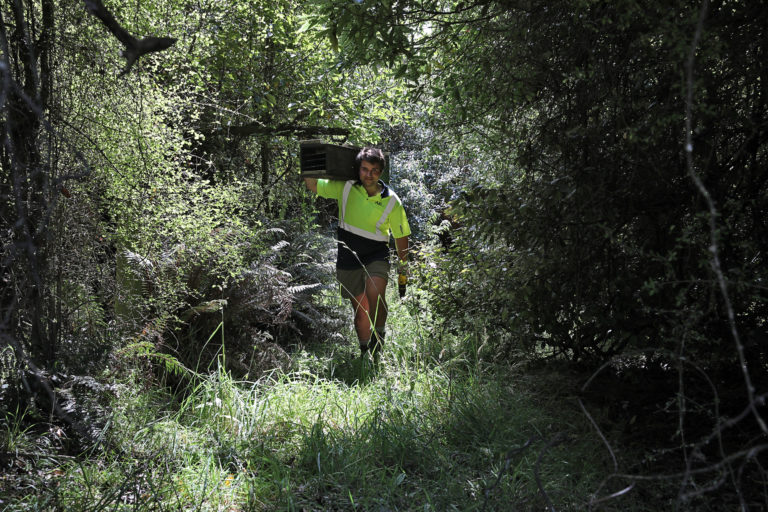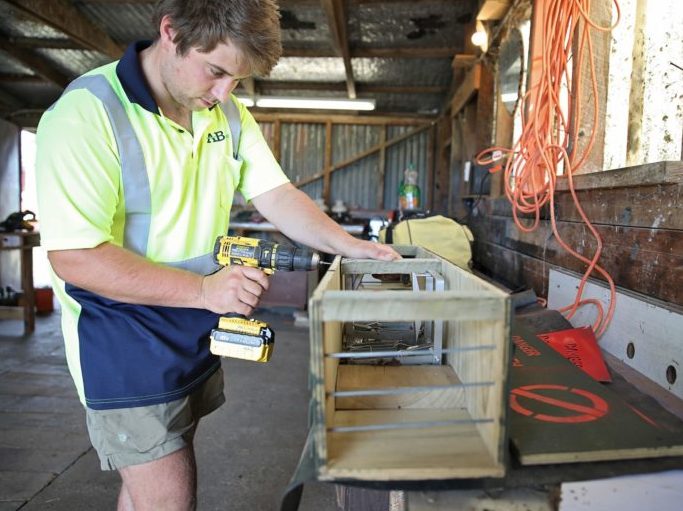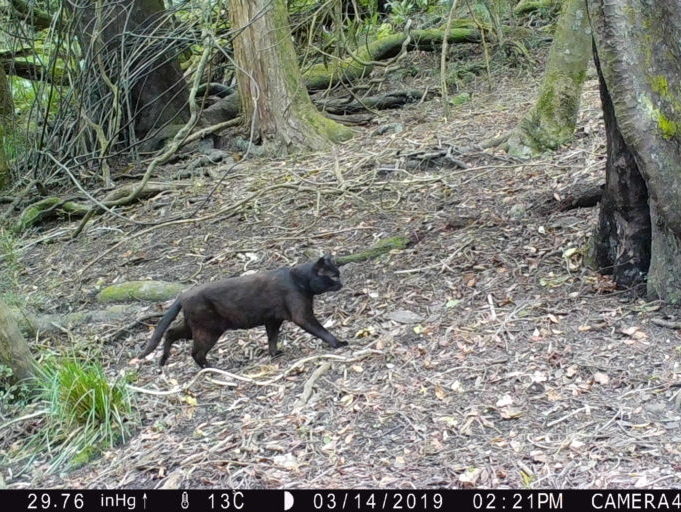On the Southland Plains near Winton, Motu Ngahere (‘Island of Bush’) is one of the very few original native bush remnants left in the area – literally an ‘island’ in the rural landscape. The name was chosen after seeking consultation with local iwi.

“It’s the last lowland rata/broadleaf podocarp forest left in Central Southland, other than ‘Forest Hill’,” says Oliver Crawshaw, who has spent the last 18 months, trapping predators, collecting eco-sourced seed from the bush and setting up a plant nursery there, after answering a classified job advert on TradeMe.
He’s loving every minute of it!
Oliver is employed by local lime company AB Lime who set up the project and are completely funding it, employing Oliver as biodiversity ranger and his colleague Ainsley Adams (environmental field officer) to carry out the work.

“AB Lime owns 75 hectares of the native bush, with its tree fuchsia, rata, totara and rimu and there’s another 25 hectares which belongs to other owners,” Oliver explains. “We’re mainly focussing on our own area at the moment, but we hope to get permission to carry our pest control on these other small areas as well. Ideally we would encourage our neighbours to fence them off as well.”
“We’ve put 120 A24 (self-resetting) traps in the bush block and have 14 double-set DOC 200 stoat traps in a buffer zone around the bush. We’ve also got possum numbers very low with poisoning and leghold traps. We’ve got some ferrets here too, but not many.”
The project is still in its early stages, but Oliver is already looking ahead.
“We’re just setting up,” he says, “working slowly but surely. From next year we hope to purchase more DOC 200 single-set traps and, with permission from our neighbours, use these to trap around the buffer. Another goal for next season is to do more monitoring.”
“We’d like to do bug density/pitfall monitoring, feral cat monitoring and bird counts. We do rat and mouse monitoring currently with 30 tracking tunnels and mice numbers suddenly went up 50% in April, but rat numbers are very low at around 5%.”
Increasing the number of tracking tunnels for more accurate rodent monitoring is also on Oliver’s work agenda. Already, some of the monitoring that Oliver currently does has led to some surprising discoveries. He uses a series of game monitoring cameras throughout Motu Ngahere to monitor pest animal presence such as deer, goats and cats. An interesting image was captured on one of the game cameras in mid-2019.
“A bird was spotted in one image that was not spotted before and none of us could positively identify it,” Ainsley recalls. “It looked to be a South Island kokako, which is thought to be extinct. Out of interest the image was sent the South Island Kokako Trust, who passed the photo onto their experts to see if they could positively identify the species of bird. Unfortunately the photo was not the best quality and the experts could not positively identify the species, but the most likely culprit ended up being a juvenile tui. The image sure drummed up some enthusiasm and excitement though with everyone weighing in on what they thought the bird might be. It has become the “ABLime Grey Ghost”, and we are all looking forward to spotting it again.”

Since starting work around Christmas 2018, Oliver has enthusiastically developed his new role beyond the initial TradeMe job description.
“We’ve developed our own nursery for plants,” he explains. “Our initial budget was for buying in plants but it’s much cheaper to grow our own. I’m eco-sourcing seed – collecting it from our own bush and growing the plants on from seed. We’ve got around 9000 plants at the moment – all sorts of plants.”
As well as the lime quarry business, AB Lime operates the regional landfill and a dairy farm running 950 cows.
“We’re retiring a lot of the steep hill country on the dairy farm. It’s too steep to farm and the cows never go there,” says Oliver. “There’s 7 or 8 hectares that used to be farmland and we’re retired the bottom half, there are 25 hectares of steep dairy farmland all up that will be retired into native bush over time. We’re also bringing back the wetlands at the base of Motu Ngahere. The lime is porous, so creates a large sinkhole area,” he explains, “But the wetlands were drained in the past. Now it’s a semi wetland on the northeast side of the bush. We’re slowly replanting that and letting the water find its natural course again.”
Oliver is planning to get stuck into some planting in the area over winter using his stock of 9000 eco-sourced plants – hopefully with some help from local school children.
“We’re hoping to involve school groups in the project,” says Oliver. “We’ve had one visit already where 120 Year 9 students planted 800 plants. We want to inspire the next generation to come and get involved. We’re learning as we go, as to how many students to have at once!” he says.
Motu Ngahere is only a 5-minute drive from nearby Winton, an easy future outing for locals.
“We want people locally to visit and realise what’s in Winton, just behind the hills,” says Oliver. “We’re planning to put in a walking track of 4 or 5 kilometres.”
Visitors who venture over the Winton hills will find “massive” totara, rimu and southern rata at Motu Ngahere along with a growing population of native birds. The spring fed streams that flow through Motu Ngahere are home to a healthy population of southern koura (Paranephrops zealandicus) a species which is nationally on the decline.
“When I first started there wasn’t a heap of birdlife,” says Oliver. “There were tui, grey warbler, fantails and bellbirds – more bellbirds than tui.”
There are falcons nesting in the bush and morepork/ruru nest in the area too.
“The lime cliff-faces make good habitat for morepork nest-sites,” Oliver explains.
Throughout the last year the bird population has started to rise, Oliver reckons, from what he has observed while working.
“There were no tomtits at the start and they’re uncommon in this area of Southland, but in the last 6 months large amounts have turned up. I’ll see 5 or 6 at a time when I’m walking the trapline,” he says.
Oliver and Ainsley work closely with Environment Southland, which has been involved since the very beginning of the project.
“About 4 years ago, AB Lime was approached by Environment Southland about the bush,” Oliver explains. “They did an Environmental Assessment. DOC got involved in coming up with some guidelines for the project and the Assessment convinced the Board of AB Lime to take the project on.”
Oliver’s own background is a great fit for both the farming and environmental aspects of his work. He grew up on a South Taranaki farm and that practical background knowledge helps when it comes to developing partnerships with farmers. He also started trapping young.
“I was always into pest control after school, in the bush and trapping possums when I was growing up. Then I left home at 16 to study at Telford (SIT rural education campus, Balclutha). After that I went commercial possum-culling in the North Island for 6 months.”
Four years deer-farming followed, along with a stint working for DOC, before Oliver joined Project Janszoon in Abel Tasman National Park.
“This new project is like a mini Janszoon,” he says. “It’s an awesome opportunity. It’s not just a 9 to 5 job, it’s a whole lifestyle!”

